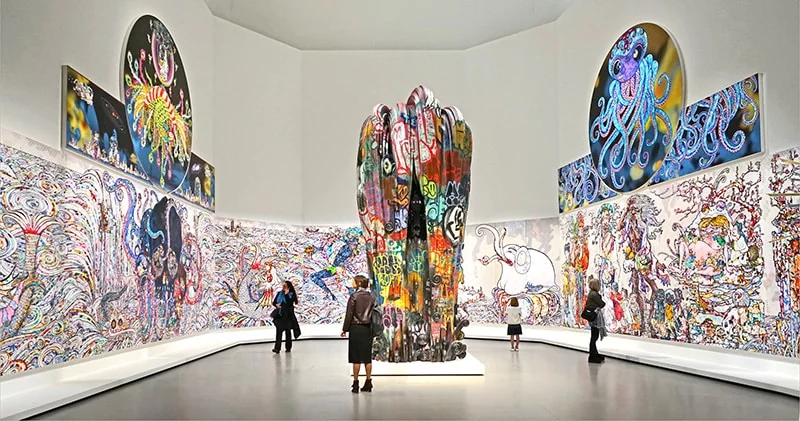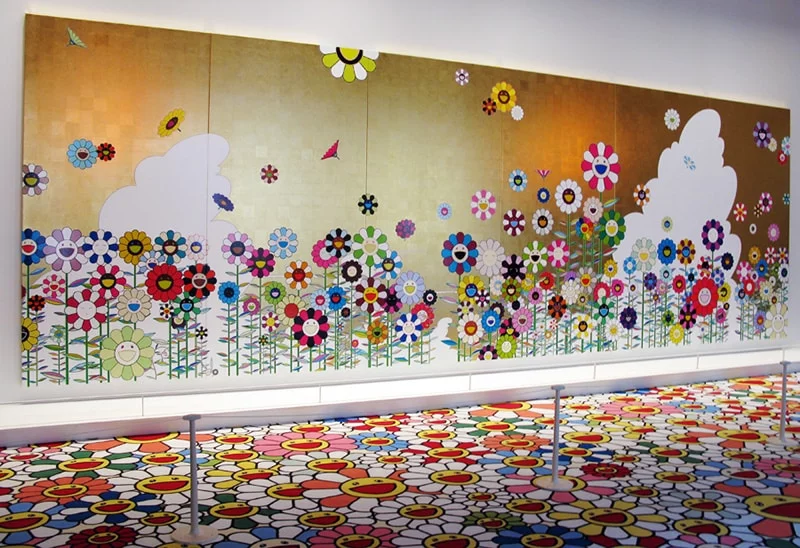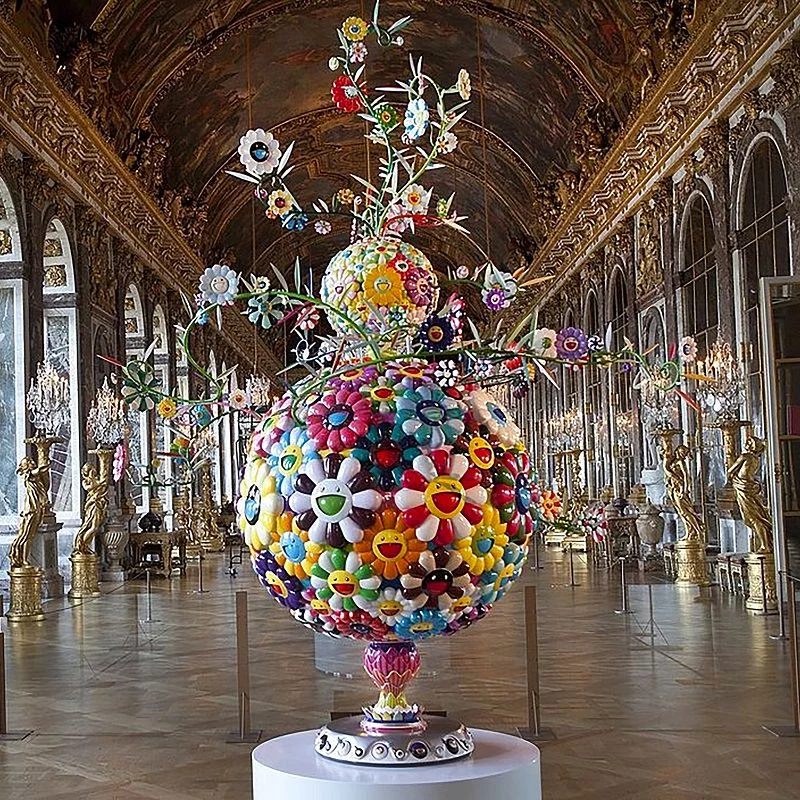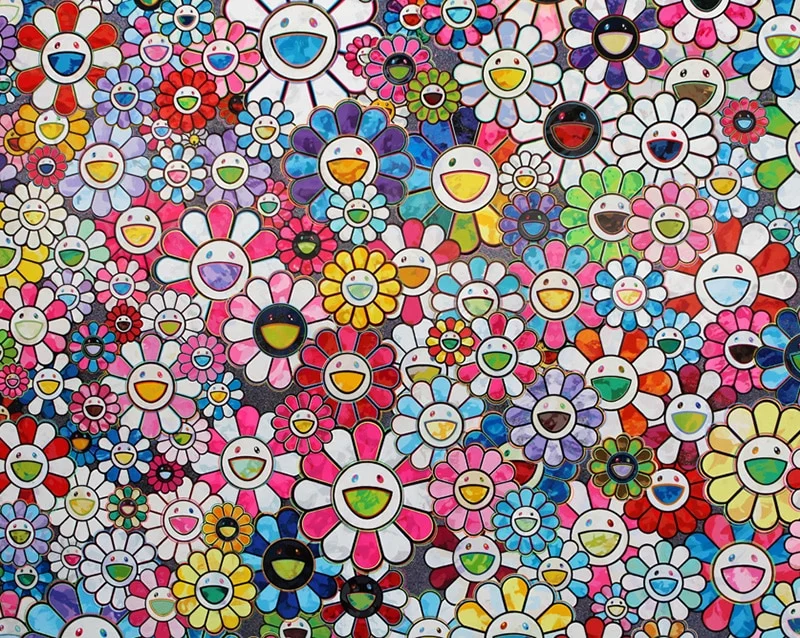Takashi Murakami, a globally acclaimed and iconic superstar of the contemporary art world, has garnered worldwide attention with his enduring flower motif.
Murakami’s flowers possess rich symbolic meanings, drawing inspiration from his personal experiences and Japan’s cultural heritage. Delving into the cultural context of Murakami’s flowers in contemporary art and popular culture, our article seeks to reflect on the artist’s lasting legacy.
Symbolism of Murakami’s Flowers
Murakami employs flowers as potent symbols to convey numerous concepts and emotions that are central to his artistic vision. His floral compositions exude brightness, infusing his work with a spirit of hope even amidst sorrow and sadness.
The smiling flower, with its grinning mouth and closed eyes, embodies joy and positivity. The flowers’ concealed tears reflect emotional reflections, representing Murakami’s own experiences while evoking the collective trauma of the Japanese people. Japanese contemporary artist, Murakami, emphasizes hope and resilience by showcasing vibrant flowers emerging from the rubble in the aftermath of earthquakes and tsunamis, symbolizing the potential for renewal.

Influence of Anime and Manga
The artist’s formative years were deeply influenced by anime and manga, which played a significant role in shaping his artistic vision. While initially studying classical Japanese painting, he gradually transitioned to contemporary art, skillfully incorporating elements of manga and anime into his creations.
Notable early works such as “And Then” and “Superflat Monogram” vividly showcase this signature style, characterized by vibrant colorsand mesmerizing patterns.
The Evolution of the Flower Motif
One of Murakami’s remarkable contributions lies in his exploration of the convergence of high and low culture, which led to the evolution of his iconic flower motif. As he embraced manga and anime aesthetics, the flowers began to assume a more direct and cartoon-like appearance.
Through meticulous experimentation with colors, textures, and sizes, Murakami eventually developed the distinctive Murakami Flowers design, featuring multiple flowers per stem set against strikingly colored backgrounds.

Exhibition and Criticism
The artist has garnered attention for showcasing his flower-themed work in renowned galleries and museums worldwide, such as the Museum of Contemporary Art in Los Angeles and the Museum of Fine Arts in Boston. Their presence at prominent art events like Art Basel and the Venice Biennale further enhances their aesthetic value and significance.
Critics have held diverse perspectives on Murakami’s flower-themed works, with some finding them captivating and joyous, while others criticize them as excessively frivolous and commercialized. Despite these differing opinions, Murakami’s flowers remain highly popular and sought-after in the art world.
Influence on the Superflat Movement
Murakami’s use of floral imagery in his works significantly influenced the Superflat movement in Japan during the 1990s. Many Superflat artists drew inspiration from Murakami’s vibrant colors, bold lines, and whimsical images, incorporating similar themes into their own work. Notably, the work of KAWS, an American artist renowned for his cartoon-like figures and vivid color schemes, showcases Murakami’s influence.

Collaborations and Partnerships
Murakami’s flower motifs have also made a significant impact beyond the art world through collaborations with artists such as Drake, Kanye West, and Billie Eilish, as well as partnerships with high-end brands like Louis Vuitton. These collaborations have resulted in memorable album covers, music videos, and advertising campaigns, solidifying Murakami’s reputation as a visionary artist with a profound influence on culture.
Mediums and Future Directions
In realizing his floral themes, Murakami employs a diverse range of techniques and media, including digital art, sculpture, and painting. The aesthetic impact of his artworks stems from his skillful use of vibrant colors, meticulous attention to detail, and innovative material use.
Recognizing the potential of art created through Non-Fungible Tokens (NFTs) as a revolutionary phenomenon akin to Pop Art, Murakami has ventured into this field, expressing his intention to delve deeper into digital media and potentially introduce his flower motifs to the realm of blockchain-based art.
A Blossoming Legacy
At their core, Takashi Murakami’s flowers have undeniably transformed both the art world and popular culture. Their prominence as iconic expressions of happiness, hope, and resilience is sustained through their symbolism, aesthetic vision, and integration into various media forms.
Murakami’s flowers have made contemporary art more accessible and familiar. They represent shared emotions and aspirations, continuously inspiring and resonating with audiences worldwide. In blurring the boundaries between high and low culture, Murakami’s flowers expand the audience’s access to and appreciation of contemporary art.





